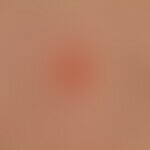Synonym(s)
DefinitionThis section has been translated automatically.
Primary, largely standardized test for the diagnosis of an allergic late type reaction of the eczema type (see below allergy), especially in allergic contact eczema. For the composition of the standard series for adults and children see table.
General informationThis section has been translated automatically.
The incidence of allergic contact dermatitis in children is reported to be between 5-20%. Children < 6 years should only be selectively tested in case of anamnestic strong suspicion, > 12 years the test can be performed according to the recommendations for adults.
According to the recommendations of the German Contact Allergy Group (DKG, valid since 1.1.2014), the standard test series in adults is composed as follows ( cited in Mahler V. 2015).
| Test substances | Test concentrations | Test bases |
| Potassium dichromate | 0,5 % | Vaseline (Vas.) |
| Thiuram mix | 1 % | Vas. |
| Cobalt (II) chloride, 6*H20 | 1 % |
Vas. |
| Perubalsam | 25 % | vas. |
| Rosin | 20 % | vas. |
| N-isopropyl-N'-phenyl-p -phenylenediamine | 0,1 % | Vas. |
| Wool wax alcohols | 30 % | Vas. |
| Mercapto mix without MTB | 1 % | Vas. |
| Epoxy resin | 1 % |
Vas. |
| Nickel (II) sulfate | 5 % |
vas. |
| Methylisothiazolinone | 0,05 % | Aqu. |
| Formaldehyde | 1 % | Aqu. |
| Fragrance mix | 8 % | Vas. (see remark) |
| Turpentine | 10 % | vas. |
| (Chloro)-methyliso- thiazolinone (MCI/MI) | 100 ppm | Aqu. |
| Paraben mix | 16 % | Vas. |
| Cetylstearyl alcohol | 20 % | Vas. |
| Zinc diethyldithiocarbamate | 1 % | vas. |
| Dibromodicyanobutane (Methyldibromo Glut.) | 0,2 % | vas. |
| Propolis | 10 % | vas. |
| Sandalwood oil | 10 % | Vas. |
| Compositae Mix II | 5 % | Vas. |
| Mercaptobenzothiazole | 1 % | Vas. |
| Lyral | 5 % | Vas. |
| Iodopropynyl butylcarbamate | 0,2 % | Vas. |
| Fragrance mix II | 14 % | Vas. (see remark) |
| Sodium lauryl sulfate (SLS) | 0,25 % | Aqu. |
| Ylang-ylang (I + II) oil | 10 % | Vas. |
| Jasmine absolute | 5 % | vas. |
Note: The broken down test substances are available in the epicutaneous test series" Fragrance Mix" and "Fragrance Mix II".
According to the recommendations of the German Contact Allergy Group (DKG), the standard epicutaneous test for children is composed of the following substances:
- Nickel sulfate
- Thiuram-Mix
- Rosin
- Mercaptobenzothiazole
- Fragrance mix I
- Fragrance mix II
- Mercapto mix
- Bufexamac
- Dibromdicyanobutane
- Chloromethylisothiazolinone
- Neomycin
- Composite mix
- p-tert-butylphenol formaldehyde resin (shoe exposure only)
- potassium dichromate (shoe exposure only)
- wool wax alcohols (only for care preparations)
- Dispersion blue mix (only for clothing)
- Paraphenylenediamine (only for henna tattoos).
The duration of application should be limited to 24 hours, further readings according to the recommendations in adults after 48 and 72 hours.
You might also be interested in
ImplementationThis section has been translated automatically.
In order to avoid a toxic skin reaction, the allergen is worked into an indifferent base (usually Vaseline) in a highly diluted form and applied (glued) to the healthy skin of the back in small test chambers made of aluminium , e.g., thin-layer foil (True-Test) or cellulose. The test reaction is regularly read after 48 hours and 72 hours, occasionally also after 96 hours. In case of questionable clinical relevance, a so-called repeated open application test (ROAT) or use use test can also be performed, in which the allergen is tested daily on the inner side of the upper arm for 1 week. A further possibility for clarifying clinical relevance is the open application test in loco.
Evaluated are:
- (no reaction = negative)
? (questionable; only erythema, no infiltrate)
+ (simple positive reaction; only erythema possibly with low infiltrate; possibly discrete papules)
++ (double positive reaction; erythema and papules, infiltrate, vesicles)
+++ (triple positive reaction; erythema, infiltrate, confluent vesicles)
++++ (quadruple positive reaction; eroded vesicles; attributed by many allergologists to the triple positive reaction)
IR (irritative-toxic reaction; soap effect, vesicle, bladder, necrosis)
nt (not tested; allergen contained in a test block but not tested)
f (follicular reaction; they are to be assigned to the reactions in question in the evaluation).
The reaction dynamics of epicutaneous testing may be included in the assessment. A crescendo or plateau pattern speaks more for the allergic type, a decrescendo pattern more for the irritant type. In case of late reactions, which occur for the first time about 10-14 days after application of the epicutaneous test, an ("iatrogenic") sensitization by the test should be considered.
Positive reactions to structurally related substances may be cross-reactions.
If positive reactions (> 5) to chemically unrelated substances occur, this may be an expression of an individually increased sensitivity to the contact allergy. Alternatively, if there are numerous positive reactions, an Angry back/Excited Skin syndrome should always be considered. In such a case, many of the morphologically positive (+ to +++) reactions will be interpreted as false positive.
If the allergic reaction does not occur in the epicutaneous test despite clear anamnestic or clinical indications of the presence of sensitization, this gives rise to the suspicion of a "false negative" reaction. This may be due to the test method (too low allergen concentration, unsuitable vehicle, poor occlusion, too short reading sequence) or to the patient's reduced immunoreactivity (e.g. due to topical or systemic medication or UV light). In case of false positive reactions, e.g. in the context of an "excited skin syndrome", or if false negative reactions are suspected, the testing of the individual substances should be repeated at a later time, but if possible only after 2 months. Other methods such as application tests (e.g. ROAT) can help to clarify sensitisation in the hands of experienced investigators.
Note(s)This section has been translated automatically.
False positive epicutaneous reactions (possibly more than 5) in the sense of a so-called angry back due to a massive test reaction to a strong contact allergen with hematogenous scatter reaction into other (negative) test areas can occur in case of too early epicutaneous testing on still eczematized skin or in case of acute eczema flare-up. On the other hand, false negative test reactions are to be expected in case of iatrogenic T-cell suppression (internal steroid therapy, antihistamines, UV therapy, etc.). Regarding previous UV exposure, a time interval of 6 weeks is recommended (Daunton A et al. 2020) .
Silent sensitization: Positive epicutaneous test result without evidence of current or past allergic contact dermatitis.
Reading of an epicutaneous test must always be followed by an evaluation of the clinical relevance of the type IV sensitization present. All information should then be documented for the patient in an allergy passport. It is useful to indicate the clinical relevance with reference to the allergen in the passport. The indication of the clinical relevance can be done by means of the so-called COADEX index. This comprises the most important, practice-relevant criteria.
The tear-off epicutaneous test is to be regarded as a modification. This test is performed e.g. to prove a persisting clinical suspicion of a contact allergy in case of a negative epicutaneous test.
Pregnancy and epicutaneous testing: According to the guideline, epicutaneous testing should not be performed during pregnancy (possible permeation of allergens).
There is the official intention to evaluate the epicutaneous test in the future according to the guidelines of the Arzneimittel- und Wirkstoffverordnung ( AMWHV), also called "Good Manufacturing Practice (GMP)". This means that ingredients e.g. of skin care products like body lotions may only be tested under GMP quality. Furthermore, since 2009 there is a notification obligation for the epicutaneous test at the competent surveillance authority according to §67 General Notification Obligation (AMG). Each practice has to informally report this to the competent drug monitoring authority of the federal state (either at the trade supervisory office or at the respective district president).
LiteratureThis section has been translated automatically.
- Bourke J et al (2001) Guidelines for care of contact dermatitis. Br J Dermatol 145: 877-885
- Bruynzeel DP et al. (2004) Photopatch testing: a consensus methodology for Europe. J Eur Acad Dermatol Venereol 18: 679-682
- Darsow U et al (1997) Allergy and atopic eczema: on the value of the "atopy patch test". Dermatologist 48: 528-535
- Daunton A et al (2020) The impact of ultraviolet exposure on patch testing in clinical practice: a case-control study. Clin Exp Dermatol 45:25-29.
- Devos SA et al (2002) Epicutaneous patch testing. Eur J Dermatol 12: 506-513
- Fartasch M et al (2008) Silent sensitization in the expert opinion - How could it be dealt with? JDDG 6: 34-39
- Kamphof WG (2003) Patch-test-induced subjective complaints. Dermatology 207: 28-32
- Pesonen M et al. (2015) Patch test results of the European baseline series among patients with occupational contact dermatitis across Europe - analyses of the European Surveillance System on Contact Allergy network, 2002-2010. Contact Dermatitis 72:154-163.
- Schnuch A et al. (2012) Allergy diagnosis with the epicutaneous test is threatened with extinction. Dermatologist 63: 250-25
- Trautmann A, Klein-Tebbe J (2013) Allergology in clinic and practice. Georg Thieme Verlag Stuttgart pp 186-245.
- Treudler R (2010) Allergic diseases in pregnant women. Dermatologist 61: 1027-1033
- Villarama CD et al. (2004) Correlations of patch test reactivity and the repeated open application test (ROAT)/provocative use test (PUT). Food Chem Toxicol 42: 1719-1725
- Worm M et al. (2007) Patch testing in children--recommendations of the German Contact Dermatitis Research Group (DKG). J Dtsch Dermatol Ges 5: 107-109
- Wohrl S et al. (2003) Patch testing in children, adults, and the elderly: influence of age and sex on sensitization patterns. Pediatr Dermatol 20: 119-123















